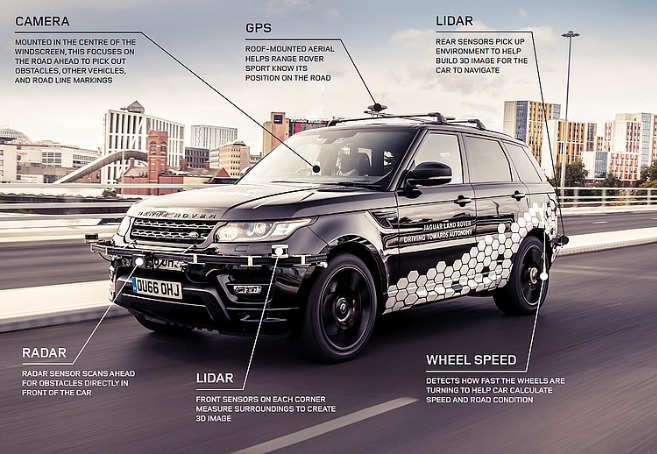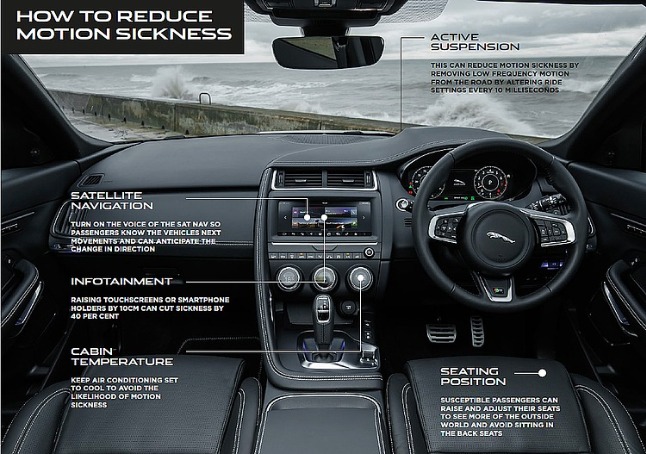THE KEY INGREDIENTS OF DRIVERLESS CARS

Jaguar Land Rover (JLR) are paving the way for driverless cars. 2025AD author Raven Brookes explores some of the exciting new features we can expect to find on their self-driving cars.
A driverless solution may be a big goal, but thousands of small solutions will make it happen. Brands are tackling one innovation at a time to bring self-driven cars to the market.
TAKE JAGUAR LAND ROVER
JLR is the UK's largest automotive manufacturer. It's built around two iconic British car brands: the world's leading manufacturer of premium all-wheel-drive vehicles, Land Rover, and premier luxury sports saloon and sports car manufacturer, Jaguar. Both have taken big steps ahead in the race to autonomous driving over the last few years with several driverless key innovations.
In their own words, this innovation is continuous. This year alone, JLR will spend an estimated £4 billion on product creation and capital expenditure. This will help them ensure by 2020 that all new Jaguar Land Rover vehicles will offer the option of some level of electrification. It will also stand them in good stead for making a commercially viable driverless car.
Here are a few of the potential key ingredients of the final product.

(Photo: https://media.jaguarlandrover.com/en)
JUST A HEADS UP
JLR has developed an intelligent system that projects the direction of travel onto the road ahead of self-driving vehicles, telling all other road users what it's going to do next.
The system, currently being trialled, will feature projections that will show when the vehicle is preparing to stop, pull away or turn. This trust-gaining move should help pedestrians and manual drivers feel safer when sharing the roads with driverless cars.
Pete Bennett, Future Mobility Research Manager at Jaguar Land Rover: "The trials are about understanding how much information a self-driving vehicle should share with a pedestrian to gain their trust. Just like any new technology, humans have to learn to trust it, and when it comes to autonomous vehicles, pedestrians must have confidence they can cross the road safely. This pioneering research is forming the basis of ongoing development into how self-driving cars will interact with people in the future.”
NO MORE RED LIGHTS
According to the Telegraph, new research conducted by the comparison website confused.com, revealed British motorists who drive every day spend a fifth of their drive-time waiting at red lights. Solving what has been called the '150 year problem', JLR has developed new technology which uses Vehicle-to-Infrastructure (V2X) to connect cars to traffic lights. This is so drivers can avoid getting stuck at red, freeing up the flow of traffic, reducing both congestion and emissions in cities.
The technology, that is currently being trialled on a Jaguar F-Pace, works by communicating with the traffic light to determine how long the light will remain red. Then the Green Light Optimal Speed Advisory (GLOSA) technology tells the driver the speed to drive to avoid getting stuck at red lights. Eventually, the GLOSA will communicate directly with the engine in driverless vehicles, ensuring it drives at an appropriate speed without having to slow down.
Applied or not, this system will improve congestion and reduce the emissions created from harsh braking or accelerating as drivers race to beat, or react late, to traffic lights. This ultimately means cleaner air, and less risk of incidents.

(Photo: https://media.jaguarlandrover.com/en)
DOWN WITH THE SICKNESS
Motion sickness is a big problem for passengers. And, when every person in the car is a passenger, nausea could become a problem.
But pioneering JLR motion sickness research has identified techniques to reduce effects by at least 60%. First, a complex algorithm calculates individual ‘wellness scores' for the driver and passengers. Then, vehicle dynamics and cabin settings will automatically adapt to individuals' needs and work together to prevent sickness.
RING AROUND THE CITY
JLR plan to make self-driving vehicles a reality within 10 years. This may seem like a tight deadline, but the trials have been promising.
In October 2018, a Range Rover Sport completed the first ever public self-driving journey, with a lap of one of the UK's most challenging road layouts, the Coventry Ring Road. This was a part of the £20 million government-funded UK Autodrive project. The Sport proved it could easily handle the famously plentiful and difficult junctions, slip roads and lane changes - all autonomously and within the 40mph speed limit.
And it doesn't stop there. JLR says they are still pursuing their 2016 goal of developing cars to acquire 'driver-like reactions' therefore becoming more 'human'. The system is expected to adapt to traffic situations in a manner comparable to the natural driving behaviours of humans. Its aim is to further foster trust in driverless technology, only this time by ensuring that autonomous cars will not behave like robots.
While ten years may feel very far away, progress is rapid. And, as JLR are proving, every successful trial brings us closer to a driverless future.
Source - https://www.2025ad.com/latest/2019-03/the-key-ingredients-of-driverless-cars/
THE KEY INGREDIENTS OF DRIVERLESS CARS
Modified on Thursday 18th April 2019
Find all articles related to:
THE KEY INGREDIENTS OF DRIVERLESS CARS



 Add to my Reading List
Add to my Reading List Remove from my Reading List
Remove from my Reading List






























